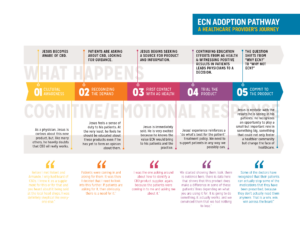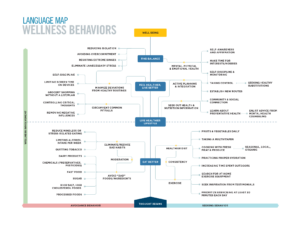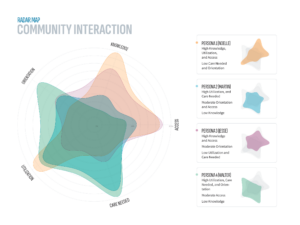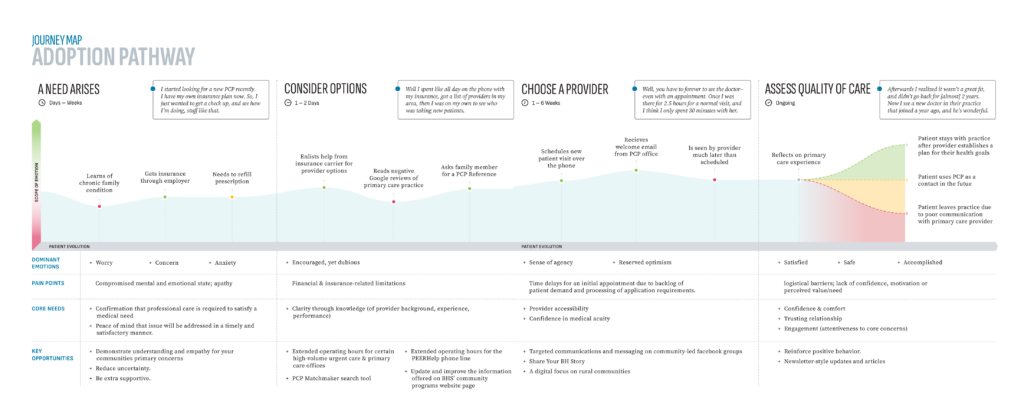The Value of Mapping in Healthcare Marketing: Uncovering Patient Insights for Consumer Marketing and Education Excellence
In today’s increasingly empathic healthcare marketing landscape, understanding stakeholder (patient, caregiver, and clinical staff) experiences is crucial to crafting marketing strategies that not only drive financial success but also improve the well-being of entire communities.
At LIFT Healthcare, we advocate for an insights-first approach to healthcare marketing that prioritizes human understanding through qualitative research. One of the most effective tools for organizing and analyzing this qualitative data is the use of journey maps and other mapping tools like expectation maps and context maps. These tools allow healthcare marketers to explore the patient’s experiences, motivations, and concerns from start to finish, providing valuable insights into healthcare consumer behavior.
By utilizing various types of maps, we transform qualitative research in healthcare into actionable insights that guide healthcare content marketing campaigns, patient education initiatives, and the development of marketing strategies that are both financially accountable and economically impactful.
In this blog post, we’ll explore the importance of mapping techniques, focusing on how they emerge from qualitative research and how they fuel consumer journey understanding, digital marketing planning, marketing ROI, and patient education.
The Power of Mapping in Healthcare Marketing
Journey maps, expectation maps, and context maps are more than just visual tools; they are research-driven representations of patient experiences and realities. Each type of map provides unique perspectives that can be used to plan more effective healthcare marketing strategies.
Journey Maps – These maps illustrate the patient (or any related stakeholder, e.g., family member or caregiver) journey, from initial awareness of a healthcare need to post-treatment follow-ups and beyond. Journey maps help healthcare marketers visualize touchpoints and intersections in the patient experience—uncovering friction points, opportunities for engagement, and areas where the hospital or health system can make good use of marketing and healthcare educational content.

Expectation Maps – These maps focus on the stakeholder’s expectations at various stages of their healthcare and wellness journey. Expectation maps identify gaps between patient expectations and actual experiences, revealing where hospitals can align their messaging, services, and touchpoints with what consumers hope to experience.

Context Maps – Context maps explore the environmental, cultural, and emotional factors that shape the patient’s healthcare journey. Context maps consider the “typical” aspects of stakeholder reality such as socioeconomic conditions, along with other important facets such as family dynamics, cultural beliefs, lived experiences, and competency. These maps offer a deeper understanding of the patient’s world and the context in which they make healthcare decisions.

Fueling Consumer Understanding with Journey Maps

One of the most critical advantages of journey maps is their ability to reveal the emotional and psychological realities of patients at each stage of their healthcare journey. This aligns directly with LIFT Healthcare’s philosophy of combining qualitative insights with quantitative data to build a comprehensive understanding of audiences.
For instance, a journey map may show that a patient with a chronic illness feels overwhelmed when researching treatment options online but is more comfortable and confident when speaking directly with a healthcare provider. This insight can fuel digital marketing strategies by showing that patients may need additional guidance or reassurance earlier in the journey. Understanding these emotional stages allows marketers to craft empathetic content and outreach strategies that speak directly to the patient’s needs, rather than focusing solely on promoting services.
Through this approach, we can design content that resonates emotionally, helping hospitals build trust and guide patients through the complex healthcare system. By tapping into patients’ fears, hopes, and motivations (three of the Five Dimensions of Emotional Truth), hospitals can become more than just service providers—they can become trusted partners in the patient’s health and well-being, while also achieving financial return on investment.
Mapping Tools for Planning Digital Marketing Strategies
Qualitative insights help hospital marketers create valuable mapping tools that provide vital context for planning digital marketing campaigns.
Journey maps enable marketers to identify the optimal times and platforms to reach patients. By pinpointing where patients are most engaged in their decision-making process and where the brand intersects with the consumer, marketers can position their content more effectively. For example, if a journey map reveals that patients search for online reviews right before making an appointment, this insight can be leveraged by creating campaigns focused on testimonials and patient success stories.
Expectation maps can highlight gaps between what patients expect to find online or in the clinical environment and what is actually provided. If patients expect to easily find information about appointment availability but are met with complex navigation and unclear details, they may abandon the journey altogether. Or, if a patient is met with phone tree complexity or staff ambiguity when seeking care, they become frustrated with your brand. By mapping out these expectations, marketers can ensure that touchpoints are optimized to meet patient needs, improving engagement rates and, ultimately, conversion rates—not to mention brand credibility.
Context maps, on the other hand, provide a deeper understanding of the patient’s background and environment, helping marketers tailor digital marketing and content strategies to resonate with the cultural needs of specific populations. For example, a context map might reveal that a particular community values in-person consultations over telehealth services due to technology access issues or cultural preferences. Digital marketing strategies can then be adjusted to emphasize local, accessible care options and personalized service.
By using these mapping tools, healthcare organizations can create hyper-targeted, relevant content that improves engagement, educates patients, and drives more appointments. LIFT Healthcare’s insights-first approach ensures that these maps are grounded in real human understanding, making them invaluable tools for building digital marketing strategies that truly resonate.
Leveraging Journey Maps for Patient Education
Journey maps and expectation maps are powerful tools for planning patient education initiatives. Education is a crucial part of the healthcare experience and must be a priority for marketers. Mapping allows healthcare marketing professionals to design education materials that meet patients where they are—both physically and emotionally.
For example, a journey map might reveal that patients diagnosed with diabetes are overwhelmed immediately after diagnosis but are more open to learning about lifestyle changes once they have had time to process their diagnosis. By understanding these emotional transitions, hospitals can create a phased approach to education content that delivers the right information at the right time.
Expectation maps help clarify what patients expect from educational materials. If patients expect information to be visual and personally relatable, for instance easily digestible and presented in video format, hospitals can adjust their content marketing and education strategy to incorporate multimedia content that caters to these preferences. This not only improves the likelihood of engagement, but engaging and relevant content empowers patients to take an active role in managing their health, contributing to long-term outcomes that align with public health philosophies.
Conclusion: Mapping for a Better Marketing Outcomes
In healthcare marketing, understanding the various aspects of the consumer journey is essential. Journey maps, expectation maps, and context maps allow marketers and healthcare providers to see beyond surface-level engagement metrics and dive deep into the emotional, psychological, and contextual factors that shape the patient experience.
